Ipswich’s Forgotten Railway
serving
the Grove and Dales brickyards
by Patrick Enfield. Published
in Suffolk Fair magazine,
August 1981
["My great great grandad brought his family down from Clackmannan. He
was Joseph Paterson. His son, Thomas, was my granny's father and he
lived in a Grove Cottage and was a bricklayer. She was called Jane
Dougal Paterson. She told me she remembered walking across fields to go
to school. Not sure which school. –Jen Greatrex"
Jen has also sent this article about the Dales brickyards, where her
great great grandfather gets an honourable mention.]
See also our Brickyards
page for more on the Grove and Dales brickyards and a map of the light
railway.
My great grandfather, George
Airy,
who was one of the Great Eastern Railway Company's 'crack' express
drivers, once told me that when he drove directors of the company down
the line to Felixstowe to admire their recent acquisition, little was
to be seen from either side of the embankment which carries the line
from Norwich Road railway bridge into Westerfield but open fields.
Apart from agriculture, only one industry was present – brickmaking.
"The high grounds about lpswich are
composed of sands and brickearth, the greater part of which
appears to belong to the period of the middle glacial … At the
brickworks on the Henley Road the boulder clay is worked and ground up
for the manufacture of various articles and frequently good specimens
of ice-marked stone may be obtained here," wrote the author of an
Ipswich directory published in 1900.
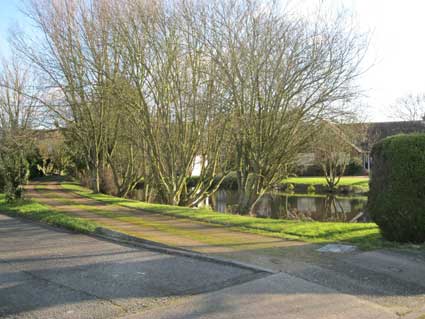 The pond at the end of The Grove: a
remnant of the brickyard?
The pond at the end of The Grove: a
remnant of the brickyard?
Many years before that was
written, John Luff of Tuddenham had established a brickworks at the top
of Sherrington Road opposite Broom Hill Swimming Pool. After closure
this became, for a time, a miniature rifle-range and the site is now a
recreation ground adjacent to the Old People's Home. However, it is
another brickworks in the area which concerns us.
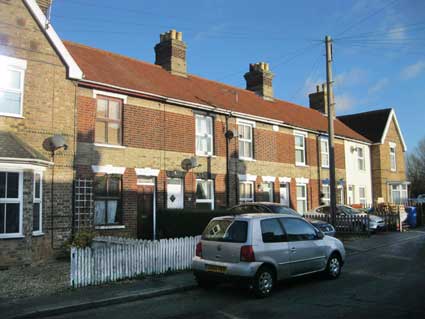
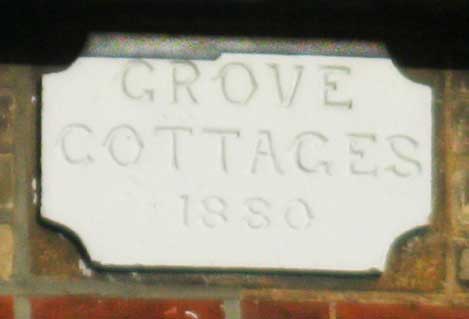 2015 images
2015 images
Off Henley Road a short cul de sac
leads to Grove Farm and there in the last century R.G. Kirton, in
association with Alfred Beaumont, opened the Grove Brick Yard. Nearby
stood Grove Cottages, built in 1880, which one year later provided
homes for three employees: Thomas King, William Kennel and William
Spurling. R.G. Kirton, who managed the concern, lived further off
with his family of six children in a separate dwelling called
Boulder House, situated midway between Dales Hall Lane and Henley Road,
a site which has now disappeared beneath the gardens and houses of June
Avenue.
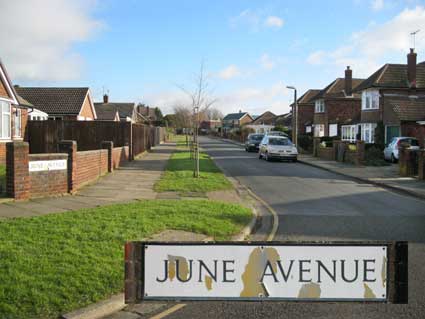
R.G. Kirton started his business with
a capital of £200 and attempted to bring out a patent chimney pot which
unfortunately failed to catch on. Financial difficulties engulfed him
and he appeared before a London Bankruptcy Court in June, 1886, when he
stated that Messrs. Rosher and Company had taken over his liabilities
of £350 and given him £90 for the business.
The acquisition by F. Rosher and
Company of the Grove Brick Yard coincided with a period of rapid
expansion and change. The firm was London based and directed similar
enterprises at Blackfriars, Chelsea, Limehouse and at Sittingbourne in
Kent. ln lpswich it had riverside premises at New Cut East, probably
those originally operated by Jonathan Chinnock and Company as a glazed
stoneware depot at Three Cranes Wharf [see our Wet Dock map].
F. Rosher and Company were determined
to exploit their newly acquired brickworks in lpswich to the
limit. They thought in big terms. The existing brickworks were greatly
enlarged and a new one constructed at the end of a rough cart
track leading off Dales Hall Lane (the future Dales Road).
The distance between Westerfield
Station and the Eastern Counties Brick and Tile Works, which was the
grand title now conferred upon the "upper" brickworks formerly
known as Grove Brick Yard, was negligible. In order to avoid the
awkward indirect haul by road the directors decided to link their
brickworks with Westerfield Station by means of a narrow gauge railway.
Accordingly an advertisement was prepared which invited tenders for the
construction of a short line three quarters of a mile long. None of the
replies satisfied Messrs. Paterson and Dixon, a nephew of Mr. Rosher,
who had come down from Scotland with Mr. Paterson in 1885 to help run
the business. Surely the job might be done more cheaply? Certainly
there was no lack of either ballast or willing hands.
One of the platelayers at Westerfield
Station was persuaded to leave the railway. He was put in charge of a
construction gang and work commenced. The line pursued a sinuous course
and one amusing story of its construction concerns the manner in which
the construction gang solved the problem presented by curving the
straight rails. As the men lacked machinery with which to do this they
placed the rails upon wooden blocks and jumped on the rails until they
assumed the desired shape. This would have been impossible had the
rails possessed a standard gauge section.
Little information has been preserved
regarding the rolling stock. The locomotive was an 0-4-4 coupled tank
engine constructed in Leeds in 1887. Mr Maude, who has lived in the
immediate vicinity of the "lower" brickworks for many years,
recalls that the waggons were of two types: flat trucks carried the
bricks and pottery whilst tip-up hoppers carried the coal.
Production was divided between the
two brickworks. The upper brickworks specialised in pottery where
tiles, drainage pipes, chimney pots, flower pots and pots for blanching
seakale were made under the supervision of the Wingroves, father and
son. The lower brickworks concentrated upon the manufacture of bricks.
The company's locomotive, driven by Joseph Paterson who also carried
out repairs, moved these artefacts up to Westerfield Station where they
were unloaded and stacked. The train then made the return journey to
the brickworks loaded with coal for the kilns.
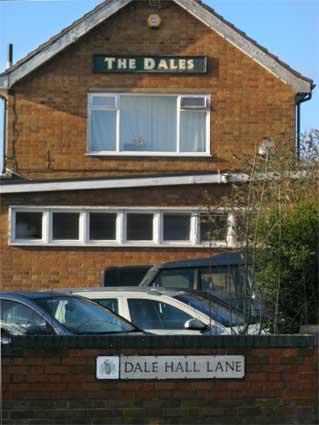
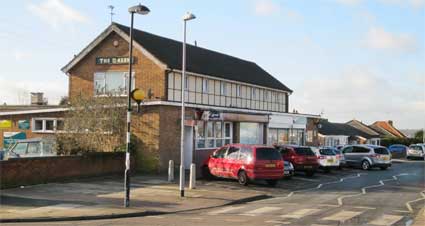 Top of today's Dales Road
Top of today's Dales Road
[See the 1930 map of the Grove/Dales brickyards for the location
of Dale Hall, which gives this area its name.]
Victorian manufacturers often built
houses for their employees and this may have been the first with
respect to a terrace of seventeen houses known as Prospect Cottages.
These stood in Dales Road on a site now occupied by The Dales public
house, its adjacent supermarket and two bungalows. Eight 'brickmakers'
lived in Prospect Cottages in 1891: James Kemp, John Woods, Alfred
Mills, Thomas Daldry, E. Prentice, John Morgan, Fulcher and Henry
Welham (foremen).
Three years later Mr C. Bagshawe
Dixon was living at Crosslea House which still guards the
entrance to the cul de sac which leads from Henley Road to
Grove Farm. Its massive, square, three storied red brick tower singles
it out for attention amongst its neighbours. [It seems clear that by the late 20th
century this house had been demolished and that recently-built houses
to the left of The Grove entrance now occupy the space.] It
became the company's
office and remained as such after Mr Dixon moved away to Elton Park in
Hadleigh Road. Mr Joseph Paterson occupied a house called Netherton
near Grove Cottages. Both men were therefore a part of what was in
effect an enclosed village community separated from the rest of
lpswich. F. Rosher and Company were not unmindful of the welfare of
that community which was dominated and unified by its raison d'etre
brickmaking. A social club was established and there was a works band
which became a popular attraction at fetes and social functions.
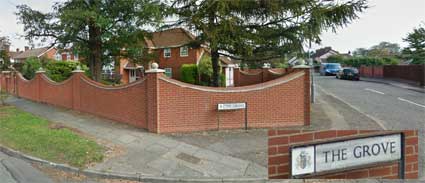 Site of
Crosslea House
Site of
Crosslea House
F. Rosher and Company appear to have
operated the two brickworks for a period approaching twenty years. By
1904 the concern had come back into local hands as a result of its
acquisition by Bolton and Laughlin. Both these gentlemen lived in
Henley Road: the former at Lyndale and the latter next door at
Daleside. The name Laughlin disappeared after the Great War and the
business thenceforth was known up to its closure in 1959 as A. Bolton
and Company Ltd.
Reference has already been made in an
earlier paragraph to a rough cart-track leading off Dales Hall Road,
and it appears likely that it was the imminent transformation of this
into a made-up road leading into Norwich Road which contributed
towards the closure of the railway. In 1921 before the proposed new
road bad become a reality, the little-used railway and the upper
brickworks near Grove Farm were described as 'disused' and by
1927 the tracks had been lifted. It is indeed fortunate that the
magnificent revised Ordnance Survey map of 1902 with its generous scale
of 25 inches to the mile, has recorded for posterity in precise and
comprehensive detail every yard of the two mile long line as it
then appeared. From this it is possible to give an exact description of
its course between the termini at Westerfield Station and the
lower brickworks erected in Dales Road.
The traveller who passes through
Westerfield Station on his way to Ipswich will probably have cast a
cursory glance at the vacant stretch of uneven ground on his Ieft which
comes into view immediately after his train has left the crossing
gates. That "stretch of unneven ground" was once the transfer siding.
From Westerfield Station Ipswich bricks and tiles were sent to all
parts of the country for A. Bolton and Company Ltd. had built up a high
reputation for their products. In 1932 the official handbook of lpswich
stated that:
"The works of A.
Bolton & Co. Ltd. have been established for many years, and produce
red and multi-coloured facing bricks, moulded bricks, arch and rubber
bricks, creasing and roofing tiles and fire-place briquettes all of
excellent quality. Among the many buildings in which the firm's
facing bricks have been used are the lpswich housing schemes, (which at
that time would have included the Racecourse and Gainsborough estates),
Public Library, the East Suffolk and lpswich Hospitals, Greenwich
Baths, Martlesham Aerodrome and Lloyds Bank, Littleport."
Let us return to our traveller.
Should he care to look down the line towards Ipswich he would see, a
little beyond the steps of the stile, the mouth of a cutting in
which the brick trains ran parallel with the main line. The cutting is
so deep that the locomotive and train would have been hidden from
view. The cutting is now filled with an impenetrable thicket of
brushwood.
When the line emerged from the
cutting it swung round to the left and proceeded over a field towards
the Eastern Counties Brick and Tile Works. Five eighths of a mile
from Westerfield Station there was a junction. The original line curved
sharply to the Ieft and ran down for an eighth of a mile between some
large rectangular areas filled with water, probably reservoirs or "pug"
basins, and ended in a Y terminus beyond some kilns.
From the junction the one and
three-eigths of a mile extension straightened out and passed by an
enormous depression, visible to this day, the result of
several years’ extensive excavation for brickearth and boulder clay,
before it reached a second junction from which a spur led off a short
distance to the left. The line now passed beneath a small oblong
structure, probably the engine shed, and then took a diagonal
north-east/south-west path between Grove Farm and the Mission Hut, long
since converted into a private house.
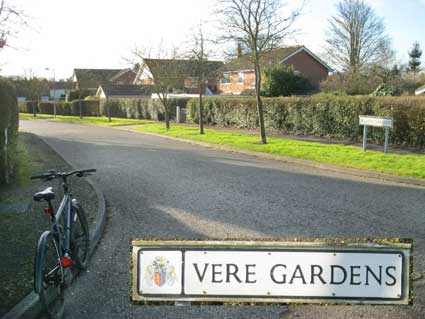
From Grove Farm the line proceeded
southward in a direction and position which brought it almost parallel
with the present public footpath between Grove Farm and Valley Road.
Almost half way down, the line swung round to the right in a great
ninety degree curve, necessitating slight banking and cutting, and then
ran under a bridge beneath Henley Road. Part of this "great curve" now
lies beneath the recently-erected houses belonging to Vere Gardens
estate. Apart from the deep cutting at Westerfield Station, the Henley
Road railway bridge, or rather part of the same, is now the only
tangible evidence that the railway ever existed. It is remarkable that
in view of all the developments which have taken place in the area and
a lapse of some ninety years, that one parapet of that railway should
still survive.
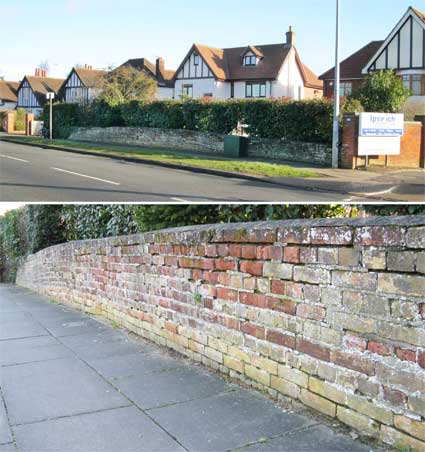 Bridge parapet outside 110 Henley Road
Bridge parapet outside 110 Henley Road
The short stretch of line between
HenIey Road and Dales Hall Lane was supported upon a low embankment,
the sole example in its entire length, and the line passed under Dales
Hall Lane beneath a second and more narrow bridge of which not a trace
remains; though the distance between the level of Dales Hall Lane and
that of Baronsdale Close, confirmed by the blank wall in which the
latter ends, is evidence enough to those with some knowledge of the
railway.

From Westerfield Station to Dales
Hall Lane the line had an unexciting, even gradient; but from Dales
Hall Lane it fell away quite dramatically and one imagines that the
small locomotive would have found the steep haul up from the brickworks
to Dales Hall Lane very taxing. Miss Madge Borrett, an Ipswich resident
now in her eighties, recalls that this event was always accompanied by
much fuss and splutter.
Running almost in a straight
east-west direction from the great curve the line veered to the right
after leaving the second bridge, presumably to avoid the pond, though
there were also two large pits, now filled in, until it met Dales Road,
which it skirted for the rest of its distance to the terminus by the
kilns. Two spurs were sent off to the left.
The entire line consisted of single
track and the absence of both turntable and loop raises some questions
concerning the way in which the trains were propelled. Did the
locomotive pull the trains up from the brickworks? If so, in order to
head the train back, it must have shunted the unloaded waggons into the
cutting, separated, and waited on a tiny spur which led off at that
point whilst the empty waggons were man-handled back so that if might
be attached to the front. If this did not take place, the original
train – now heavily laden with coal – would have been let down the
steep
gradient below Dales Hall Lane by a straining locomotive in reverse
acting as brake, its wheels probably slipping badly on wet rails in
inclement weather. Perhaps the train was permanently headed by the
locomotive facing towards the lower brickworks so that the trains were
pushed up the gradient and backed into the transfer siding?
A second mystery surrounds the
abandonment of the line. Here there is more light, for it is known that
this coincided with the retirement of the driver Joseph Paterson just
after the Great War. After a quarter of a century's wear and tear it is
more than likely that the locomotive would have been in need of
fundamental repair, if not replacement, and possibly the cost involved
plus the necessity to hire someone to both drive and maintain the
locomotive might have been considered extravagant by Bolton and
Laughlin, especially as the upper brickworks had hen closed and Dales
Road now provided an easy outlet to Norwich Road. These considerations
rest upon a speculative basis; but there is evidence to support that
basis and nothing to contradict it.
The "enclosed village community"
referred to earlier produced some fine examples of long service amongst
the brickworkers; and it is appropriate here to record two names
amongst those who remained to the end: Mr. Charles Spurling, who
commenced work at the brickworks at the age of 13 as the son of William
Spurlins who had worked at the Grove Brick Yard for Beaumont and
Kirton, the original proprietors; whilst Mr. Fred Lewis, the last
foreman, and his father and grandfather were likewise employees whose
combined service spanned many decades.
At the time of closure it was stated
that the workforce had declined within three years from twenty to six
and that production had fallen from 60,000 bricks per week to 20,000.
Quicker and cheaper methods of mechanical production and foreign
competition were said to be the cause of closure, though those reasons
did not impress the workers who considered that their hand-made Suffolk
“reds” were of superior quality.
[The above text taken from an
articled by Patrick
Enfield published
in Suffolk Fair magazine,
August 1981.]
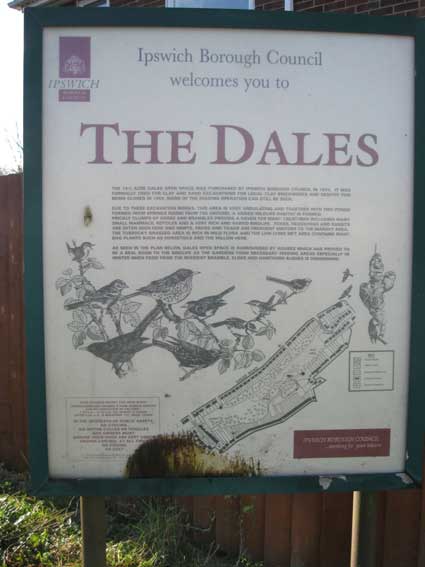
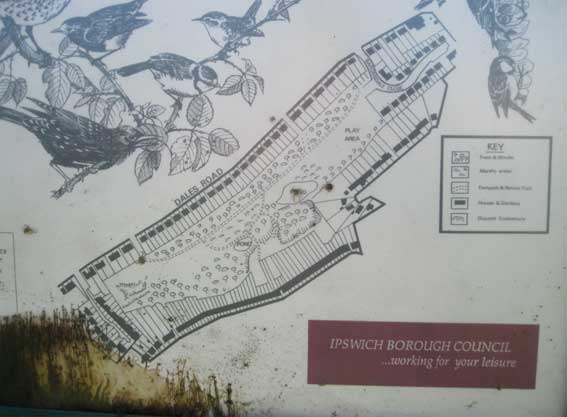
Here is the Ipswich Borough Council information board which stands at
the entrance to today's green space/playground.
"The 141/2 acre Dales open
space was purchased by Ipswich Borough Council in 1973. It was formerly
[not 'formally': sic] used
for clay and sand excavations for local clay brickworks and despite
this being closed in 1959, signs of the digging operation can still be
seen.
Due to these excavation works, this area is very undulating and
together with two ponds formed from spring rising from the ground, a
varied wildlife habitat is formed. Prickly clumps of gorse and brambles
provide a haven for many creatures including many small mammals,
reptiles and a very rich and varied birdlife. Foxes, hedgehogs and
rabbits are often seen here and newts, frogs and toads are frequent
visitors to the marshy area. The tussocky grassed area is rich in wild
flora and the low lying wet area contains many bog plants such as
horsetails and the willow herb.
As seen in the plan below, Dales open space is surrounded by houses
which has proved to be a real boon to the birdlife as the gardens form
necessary feeding areas especially in winter when food from the
resident bramble, elder and hawthorn bushes is diminishing."
See also our Brickyards page for
further examples of this Ipswich industry, from Wherstead Road to the
California estate.
Link for another page of research and
images on the Dales/Grove railway.
Home
Please email any comments and contributions by clicking here.
Search Ipswich
Historic Lettering
©2004 Copyright
throughout the Ipswich
Historic Lettering site: Borin Van Loon
No reproduction of text or images without express
written permission
 The pond at the end of The Grove: a
remnant of the brickyard?
The pond at the end of The Grove: a
remnant of the brickyard?
 2015 images
2015 images

 Top of today's Dales Road
Top of today's Dales Road Site of
Crosslea House
Site of
Crosslea House
 Bridge parapet outside 110 Henley Road
Bridge parapet outside 110 Henley Road

